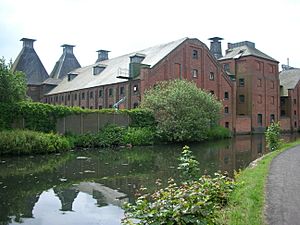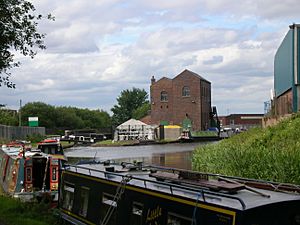Titford Canal facts for kids

The Titford Canal is a special kind of waterway called a narrow canal. This means it's only about 7 feet wide, just enough for the boats that used to travel on it. It's a short part of the larger Birmingham Canal Navigations (BCN) system. You can find it in Oldbury, in the West Midlands, England.
This canal was planned way back in 1768, but it wasn't built until 1836-1837. It officially opened on November 4, 1837. Today, the canal starts at a place called Titford Pool. This pool is a large storage area for water, like a big pond, that was made in 1773-1774. It's now partly hidden under and around the M5 motorway. The canal then flows to join the BCN Old Main Line at Oldbury Junction, which is also near the M5.
In the past, the canal continued beyond Titford Pool with other sections. One was the Portway Branch, which went to coal mines in the Titford Valley. Another was the Causeway Green Branch. These older parts of the canal are no longer used for boats.
Titford Pool: The Canal's High Point
Titford Pool is very high up, about 511 feet above sea level. This made it an important source of water for the original Birmingham Canal, which was designed by James Brindley. The canal's highest point in the Midlands is at Titford Pool, making it the highest navigable canal in the area. Only the Rochdale Canal is higher in England, at 600 feet above sea level.
Even though Titford Pool was a water source for a long time, boats couldn't use it until 1837. That's when six special water lifts, called locks, were added. These locks were next to some chemical factories. On the BCN, locks often have single lower gates. This design helps to stop water from leaking out. These Titford Locks, also known as Oldbury Locks, stopped working for a while but were fixed up in 1973-1974.
Exploring the Titford Canal
Between Titford Pool and the locks, you can see the Langley Maltings. This old building is very important and is protected as a Grade II listed building. It was once used to make malt, which is a key step in making beer. Sadly, parts of the Maltings have been badly damaged by fire.
At the very top lock, there's another important building called the Titford Engine House. This building is also Grade II listed. It was built to pump water back up the six locks from a lower canal section called the Wolverhampton Level. Later, it was mostly used to supply water to the canal itself. Today, this historic building is the main office for the Birmingham Canal Navigations Society.
Right at the top lock, another branch of the canal, called the Tat Bank Branch (or Spon Lane Branch), used to connect. This branch is no longer used by boats. It was originally a way to feed water to the Smethwick Summit. Later, Thomas Telford improved it in 1830 to send water to Edgbaston Reservoir (also known as Rotton Park Reservoir). This reservoir then supplies water to other parts of the BCN. While some parts of it were once navigable, it's now blocked and you can't walk along it.
Titford Pool, the Tat Bank Branch, and the top section of the Titford Canal are the highest points of the entire BCN system. You can get to them from Engine Street. The Inland Waterways Association even held its big National Festival here in 1978 and 1982.
Images for kids
-
Langley Maltings, before damage by fire




